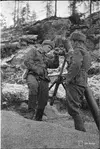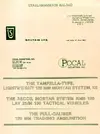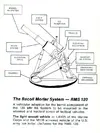D
Install the app
How to install the app on iOS
Follow along with the video below to see how to install our site as a web app on your home screen.
Note: This feature may not be available in some browsers.
You are using an out of date browser. It may not display this or other websites correctly.
You should upgrade or use an alternative browser.
You should upgrade or use an alternative browser.
Kranaatinheittimistö
- Viestiketjun aloittaja Samses
- Aloitus PVM
Mitähän hiihtäjäkuuluisuus Timo Murama sanoisi edelläolevasta tuliasemakoreografiakeskustelusta?
Muraman mietteitä voimme vain arvailla.
Minä puolestani totean että tarkkuus, huolellisuus, järjestelmällisyys ja kurinalaisuus puuttuivat osalta sotiemme ajan heitinmiehiltä. Ikävä kyllä tulos oli tuolloinkin karu, miehiä
siirtyi oikosääristen pataljoonaan kaksoislatauksen, muulla tavalla syntyneen putkiräjähdyksen tai esimerkiksi suuntauksessa tapahtuneiden virheiden takia. Sanon tämän tiedossa
olevan tosiseikan silläkin uhalla että joku katsoo minun nyt sotiemme veteraaneja loukanneen.
D
Deleted member 266
Guest
Uskoisin Muraman nyökyttelevän nykyisille menettelytavoille, keskustelusta en olisi niin varma.
Sota-aikana tuli virheitä ja miehiä kuoli, loukkaus olisi olla kertomatta ja oppimatta.
Sota-aikana tuli virheitä ja miehiä kuoli, loukkaus olisi olla kertomatta ja oppimatta.
Rajajääkäri
Ylipäällikkö
Uskoisin Muraman nyökyttelevän nykyisille menettelytavoille, keskustelusta en olisi niin varma.
Sota-aikana tuli virheitä ja miehiä kuoli, loukkaus olisi olla kertomatta ja oppimatta.
Olihan sodassa eturintamalla olevilla miehillä ihan eri paineet ja pelot, kuin jossain rauhanajan harkoissa.
Näin on asia! En nyt ehdi enempää kirjoitella, mutta viimeksi asian vahvisti täälläkin esillä ollut Pasi Kesselin tutkimus tykistön 100 v taktiikasta.Minä puolestani totean että tarkkuus, huolellisuus, järjestelmällisyys ja kurinalaisuus puuttuivat osalta sotiemme ajan heitinmiehiltä. Ikävä kyllä tulos oli tuolloinkin karu, miehiä
siirtyi oikosääristen pataljoonaan kaksoislatauksen, muulla tavalla syntyneen putkiräjähdyksen tai esimerkiksi suuntauksessa tapahtuneiden virheiden takia. Sanon tämän tiedossa
olevan tosiseikan silläkin uhalla että joku katsoo minun nyt sotiemme veteraaneja loukanneen.
AJJV
Kapteeni
Jos virheet olivat toistuvia eikä vastaavia sattunut tykistöllä niin paineet ja pelot ovat selittelyä.Olihan sodassa eturintamalla olevilla miehillä ihan eri paineet ja pelot, kuin jossain rauhanajan harkoissa.
Jos virheet olivat toistuvia eikä vastaavia sattunut tykistöllä niin paineet ja pelot ovat selittelyä.
Toki riskit ovat täysin eri tyyppisiä eri välineillä. Esimerkiksi kaksoislataus vaatii kenttätykillä erityistä lahjakkuutta muttei ole krh:lla temppu eikä mikään.
kertakenttään
Ylipäällikkö
Kyse on myös paljolti kyse niistä valinnoista ja painotuksista mitä tehtiin. Heittimistö oli epäkypsä toimialana pitkään ja haki paikkaansa.
Kertauksissa aikoinaan ammuttiin näitä vanhanmallisia teräspyrstöisiä kranaatteja joissa lisäpanokset kiinnitettiin siipien väliin. Kun lisäpanoksilla ammuttiin, niin olisiko ollut peräti vain yksi kranaatti minuutissa sallittu. Ilmeisesti voivat syttyä ennenaikaisesti jos putki on liian kuuma. Jos nyt sotatilannetta miettii, jossa on pakko ampua sen mitä putkeen kerkeää tuuppaamaan, niin onko tuo kuinka todennäköistä?
D
Deleted member 266
Guest
Kyse lienee puhtaasta rauhanajan harjoituksiin liittyvästä menettelystä, joka pohjautuu johonkin - tai sitten ei. Esimerkiksi sotien aikana suurin osa 81 krh lisäpanoksista taisi olla sellofaanikoteloita ja laukauksia ammuttiin tasan niin nopeasti kuin kyettiin/tarvittiin.

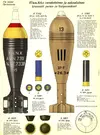
Isoisän sotareissulta 1941 (JR 56 Kollaalla):
"17.07. Kello 5.30 alkoi kaamea seremonia. Oma tykistömme ampui 50 tykin voimalla ja siihen kuoroon yhtyi heittimemme 80 ammuksella. Ryssä ampui vastaan minkä kerkesi. En alussa saanut miehiä liikkeelle korsuistaan. Joko eivät kuulleet, tai olivat muuten haluttomia. Lauri Pietilä Kaukolasta tuli, J. Toivonen ja Luovio olivat paikalla ja koska ladattuja ammuksia oli varastossa, kannoin niitä likelle ja kävihän se niinkin. Toisetkin tulivat paikoilleen ja "työ" alkoi käydä. Puhelin toimi ja pian sain onnittelut Kuljulta. Vanjan korsuun oli tullut täysosuma ja ne olivat paniikin vallassa. Kymmenen kappaletta lisää ja taas ilmoitus, että kaksi korsua, yksi kk-pesäke ja yksi pk-pesäke olivat lakanneet ja hyökkäys tyrehtynyt.
Olimme ampuneet 125 ammusta, ajoittain niin kovalla vauhdilla, että heittimen putki tuli punaiseksi ja lopetin ammunnan, koska putkiräjähdyksen vaara oli liian suuri. Sain Huhtamäen porukalta uuden putken, koska hän ei ollut saanut tulenjohtuetta, eikä saanut muitakaan toimimaan. Toisen heittimen putkeen oli Lempinen pudottanut ammuksen kärki edellä, eivätkä uskaltaneet ottaa sitä sieltä pois. Oli hullua, että Huhtamäen porukka kantoi kelvotonta putkea aina Karhumäen porteille asti."


Isoisän sotareissulta 1941 (JR 56 Kollaalla):
"17.07. Kello 5.30 alkoi kaamea seremonia. Oma tykistömme ampui 50 tykin voimalla ja siihen kuoroon yhtyi heittimemme 80 ammuksella. Ryssä ampui vastaan minkä kerkesi. En alussa saanut miehiä liikkeelle korsuistaan. Joko eivät kuulleet, tai olivat muuten haluttomia. Lauri Pietilä Kaukolasta tuli, J. Toivonen ja Luovio olivat paikalla ja koska ladattuja ammuksia oli varastossa, kannoin niitä likelle ja kävihän se niinkin. Toisetkin tulivat paikoilleen ja "työ" alkoi käydä. Puhelin toimi ja pian sain onnittelut Kuljulta. Vanjan korsuun oli tullut täysosuma ja ne olivat paniikin vallassa. Kymmenen kappaletta lisää ja taas ilmoitus, että kaksi korsua, yksi kk-pesäke ja yksi pk-pesäke olivat lakanneet ja hyökkäys tyrehtynyt.
Olimme ampuneet 125 ammusta, ajoittain niin kovalla vauhdilla, että heittimen putki tuli punaiseksi ja lopetin ammunnan, koska putkiräjähdyksen vaara oli liian suuri. Sain Huhtamäen porukalta uuden putken, koska hän ei ollut saanut tulenjohtuetta, eikä saanut muitakaan toimimaan. Toisen heittimen putkeen oli Lempinen pudottanut ammuksen kärki edellä, eivätkä uskaltaneet ottaa sitä sieltä pois. Oli hullua, että Huhtamäen porukka kantoi kelvotonta putkea aina Karhumäen porteille asti."
Last edited by a moderator:
AJJV
Kapteeni
Ammuin joukon osana noin 1000 tkr (tai siten 500 ei pysty muistamaan kummin se oli koko ajan kuitenkin kahdella heittimellä) vuoden aikana. Pelkästään vanhoja sellofaani/muovisia lisäpanoksia ja vanhoja kranuja 81 heitin. Iskut ammuttiin puolikkaina kuten rovan onnettomuuden jälkeen varomääräykset edellytti. Pari kertaa syttyi asemissa maastopalon alku joka saatiin ryhmän voimin sammumaan ja muutan kerran lataaja sai palavia roskia niskaansa, mitäs ei pitänyt sirpää kiinni...Kertauksissa aikoinaan ammuttiin näitä vanhanmallisia teräspyrstöisiä kranaatteja joissa lisäpanokset kiinnitettiin siipien väliin. Kun lisäpanoksilla ammuttiin, niin olisiko ollut peräti vain yksi kranaatti minuutissa sallittu. Ilmeisesti voivat syttyä ennenaikaisesti jos putki on liian kuuma. Jos nyt sotatilannetta miettii, jossa on pakko ampua sen mitä putkeen kerkeää tuuppaamaan, niin onko tuo kuinka todennäköistä?
Viimeksi muokattu:
Amerikkalaisten ”tukikohta-Krh”.
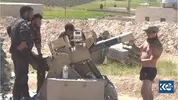
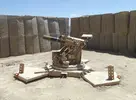




http://www.thedrive.com/the-war-zon...p-futuristic-computer-assisted-mortar-turrets...
And that’s where the AMPS would seem to come in. At its core, the system, also known as the XM905, is a relatively portable 120mm mortar on a rotating base plate so troops can fire it in any direction. Defense contractor Mistral, Inc., in cooperation with Israeli firm Elbit, produce the weapon.
Unlike many traditional infantry mortars, the weapon itself, called the XM908, has a recoil mechanism, giving it the appearance of a small howitzer, which helps reduce the shock of firing and improves accuracy. Three feet attached to the weapon's base plate further stabilize the firing platform. The mortar, a derivative of Elbit’s Cardom Recoil Mortar System 6-Light, or RMS6-L, is the same one the U.S. Army employs on some of its Stryker wheeled armored vehicles.
The weapon's base has its own battery-powered traverse system that can slew the weapon 180 degrees in 12 seconds to fire automatically at coordinates troops input into a computerized fire control system. The motorized arrangement can still aim the weapon accurately even if the platform isn’t on level ground.
The mortar has a maximum range of between four and five miles, depending on the ammunition type, which can include high explosive rounds, shells that create concealing smoke, and ones that release illuminating flares for night-time operations. Combined with the computerized fire control system, the earliest versions of the system could reportedly hit targets within an area approximately five percent as wide as the firing distance.
At longer ranges this is less precise but still highly useful – more than 250 feet at a mile – but closer in, it can deliver rapid and impressive results. The system has likely become more accurate over time as well. But more importantly, it offers immediate extended range fire support for troops at remote bases, who may not have the time to wait for other artillery or air support to become available.
...
D
Deleted member 266
Guest
Ääriesimerkkinä mainittakoon heitinjoukkue, joka kärsi suurimmat jatkosodan tappionsa nautittuaan porukalla & urakalla korvikealkoholia.Muraman mietteitä voimme vain arvailla.
Minä puolestani totean että tarkkuus, huolellisuus, järjestelmällisyys ja kurinalaisuus puuttuivat osalta sotiemme ajan heitinmiehiltä. Ikävä kyllä tulos oli tuolloinkin karu, miehiä
siirtyi oikosääristen pataljoonaan kaksoislatauksen, muulla tavalla syntyneen putkiräjähdyksen tai esimerkiksi suuntauksessa tapahtuneiden virheiden takia. Sanon tämän tiedossa
olevan tosiseikan silläkin uhalla että joku katsoo minun nyt sotiemme veteraaneja loukanneen.
Ei niin, että väittäisin kaikkien heitinmiesten juovan korvikealkoholia, eikä niin, että väittäisin heitinmiesten kuolleen pelkästään telaketjuun. Vaan niin, että kun satojatuhansia miehiä huseeraa keskenään viitisen vuotta, sattuu ylilyöntejäkin.
Kyse lienee puhtaasta rauhanajan harjoituksiin liittyvästä menettelystä, joka pohjautuu johonkin - tai sitten ei. Esimerkiksi sotien aikana suurin osa 81 krh lisäpanoksista taisi olla sellofaanikoteloita ja laukauksia ammuttiin tasan niin nopeasti kuin kyettiin/tarvittiin.
Katso liite: 20774
Katso liite: 20779
Isoisän sotareissulta 1941 (JR 56 Kollaalla):
"17.07. Kello 5.30 alkoi kaamea seremonia. Oma tykistömme ampui 50 tykin voimalla ja siihen kuoroon yhtyi heittimemme 80 ammuksella. Ryssä ampui vastaan minkä kerkesi. En alussa saanut miehiä liikkeelle korsuistaan. Joko eivät kuulleet, tai olivat muuten haluttomia. Lauri Pietilä Kaukolasta tuli, J. Toivonen ja Luovio olivat paikalla ja koska ladattuja ammuksia oli varastossa, kannoin niitä likelle ja kävihän se niinkin. Toisetkin tulivat paikoilleen ja "työ" alkoi käydä. Puhelin toimi ja pian sain onnittelut Kuljulta. Vanjan korsuun oli tullut täysosuma ja ne olivat paniikin vallassa. Kymmenen kappaletta lisää ja taas ilmoitus, että kaksi korsua, yksi kk-pesäke ja yksi pk-pesäke olivat lakanneet ja hyökkäys tyrehtynyt.
Olimme ampuneet 125 ammusta, ajoittain niin kovalla vauhdilla, että heittimen putki tuli punaiseksi ja lopetin ammunnan, koska putkiräjähdyksen vaara oli liian suuri. Sain Huhtamäen porukalta uuden putken, koska hän ei ollut saanut tulenjohtuetta, eikä saanut muitakaan toimimaan. Toisen heittimen putkeen oli Lempinen pudottanut ammuksen kärki edellä, eivätkä uskaltaneet ottaa sitä sieltä pois. Oli hullua, että Huhtamäen porukka kantoi kelvotonta putkea aina Karhumäen porteille asti."
Mikä tuon pyrstön "siipien" rei'ityksen funktio on?
Vääpeli
Greatest Leader
Lisää kantamaan.
https://www.military.com/kitup/2018/04/18/marines-hunt-mortar-round-can-fire-12-miles.html
https://www.military.com/kitup/2018/04/18/marines-hunt-mortar-round-can-fire-12-miles.html
Marines in the Hunt for a Mortar Round That Can Fire Up to 12 Miles
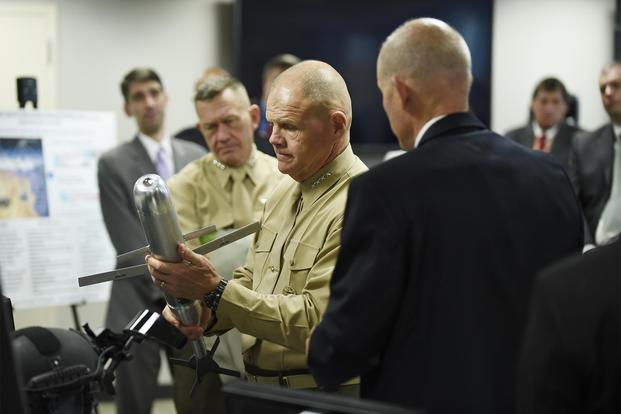
Commandant of the Marine Corps, Gen. Robert Neller, is briefed on the Advanced Capability Extended Range Mortar (ACERM) during an Office of Naval Research (ONR) awareness day. (U.S. Navy/John F. Williams)
Military.com 18 Apr 2018 By Hope Hodge Seck
The Marine Corps is investing heavily in long-range fire systems as it prepares itself for future battles.
It's a capability gap that Marine Corps leaders have spoken about publicly in recent months. At the Surface Navy Association's annual symposium in January, the head of Marine Corps Plans, Policies and Operations, Lt. Gen. Brian Beaudreault, talked about how the service planned to increase the precision and range of its existing systems in ways tailored to the Corps' main mission sets.
"We're going to very much follow what the Army is doing ... [but maintain] our interest and how we can help in the sea control fight," he said, according to a report from National Defense Magazine.
On the Marine Corps' current wishlist is an 81mm mortar round that can fire up to almost four times further than its existing high-explosive round.
In a request for information published earlier this month, the Marine Corps announced it was "analyzing market capabilities" to find a maker for the Advanced Capability Extended Range Mortar, or ACERM. The round, which would be compatible with existing Marine Corps and Army M252 81mm smooth-bore mortar systems, would have an effective range of up to 20,000 meters, or 12.4 miles.
"In support of the Infantry close fight, across the spectrum of the Full Range of Military Operations, and in all terrain and weather conditions, this capability should be reliable, responsive, and able to defeat high payoff targets," the RFI reads. "This capability includes incapacitating personnel within or behind structural barriers, inside light-skinned stationary vehicles, and in the open while minimizing collateral damage."
The ACERM has been a project under development by the Office of Naval Research for several years. But the new solicitation is an indicator that it's about to transition from a bright idea into a battlefield reality.
According to the solicitation, parameters for the high-tech round include a target accuracy of as little as one meter. The maximum objective range of 20,000 meters is almost quadruple the high-explosive round's maximum range of less than 6,000 meters.
And the round should take only five minutes to travel that 12-mile maximum range, according to the document.
The ACERM should be able to operate in a GPS-denied environment, and have the ability to hit a moving target as well as a stationary one.
Companies have until May 4 to respond to the solicitation; it's not immediately clear what next steps would be to buy or field the high-tech round.
Meanwhile, the service continues to explore other weapons system upgrades, including firing High-Mobility Artillery Rocket Systems (HIMARS) off of amphibious ships and extending the range of larger artillery systems.
-- Hope Hodge Seck can be reached at [email protected]. Follow her on Twitter at @HopeSeck.
kertakenttään
Ylipäällikkö
Jos oikein tulkitsin ja luin, niin kyseessä ei olisi tyhmä murkula vaan jonkin sortin liitoammus ala GLSDB
Oli mitä oli varmasti julmetun kallis. Mikä ihmeen idea ampua 81mm heittimellä 20km päähän? Eikös tykistö ole sitä varten.


